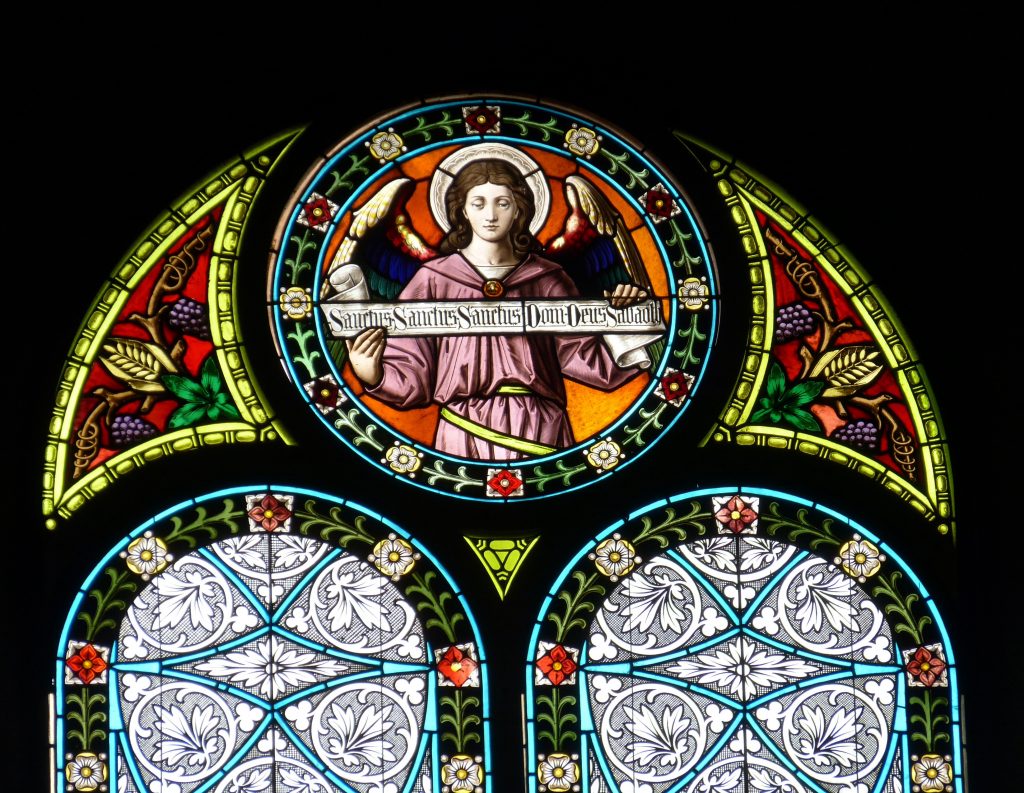The U.S. bishops are encouraging Catholics to deepen their love for the Eucharist as part of the ongoing National Eucharistic Revival initiative. In light of that effort, the following is the first in a series from Angelus contributing editor Mike Aquilina on the meaning and makeup of the Eucharistic Prayers.
“Holy! Holy! Holy!”
So we sing (or say) at every celebration of the Mass.
We call it the “Sanctus” (Latin for “Holy”) or the “Trisagion” (Greek for “Thrice-Holy”), and it marks the beginning of the Eucharistic Prayer, the most important moment in our worship.
In fact, God’s people have used it in worship since centuries before the coming of Jesus. In many ways, it is the song at the heart of biblical religion.
The prophet Isaiah provides history’s first witness to the use of the hymn. He heard the seraphim sing it on a particular day in the year King Uzziah died, around 740 B.C.
While serving as a priest in the Temple, Isaiah suddenly has a vision of the worship that takes place in heaven. He sees six-winged seraphim standing at God’s throne. “And one called to another and said: ‘Holy, holy, holy is the Lord of hosts; the whole earth is full of his glory’ ” (Isaiah 6:3). Awestruck and terrified, Isaiah recognizes that he stands in the sight of God, his judge, and he is profoundly conscious of his own sins: “Woe is me! For I am lost; for I am a man of unclean lips, and I dwell in the midst of a people of unclean lips” (v. 5).
Ever afterward the hymn was integral to Jewish piety. It appears in ancient texts, some of which predate the Gospel, such as the “First Book of Enoch,” the “Testament of Abraham,” and the “Apocalypse of Moses.” There is evidence that it was used in the liturgy of the Jerusalem Temple. And it was sung in the synagogue — and still is today. Scholars believe that in the practice of the Jerusalem Temple the “Sanctus” was followed by a “Benedictus,” an invocation that begins, “Blessed is he…” (perhaps Ezekiel 3:12 or Psalm 72:19).
Chanted in these places, the “Holy, Holy, Holy” represents a correspondence between worship on earth and in heaven. God’s people raise the same hymn offered by his angels.
For the Jews this was a sign of restoration, of harmony between God and his people. In one apocryphal text, Adam recalls that the “Trisagion” was the mid-morning prayer of the seraphim, and in Eden he could hear them sing it. “But after I transgressed against the law,” he adds, “I no longer heard that sound.”
With the arrival of the Gospel, the song remained at the heart of the Bible’s understanding of worship. In the Book of Revelation, John recorded heavenly visions like Isaiah’s, but he describes them in greater detail. In chapter 4 he shows us “four living creatures,” each with six wings, “and day and night they never cease to sing, ‘Holy, holy, holy, is the Lord God Almighty, who was and is and is to come!’” (Revelation 4:8).
The “Sanctus” likely became part of the Church’s ritual public worship at a very early date. Pope St. Clement mentioned it in his letter to the Corinthians, written in the second half of the first century. Several bishops of the early Church discussed the “Sanctus” in their preaching for Easter Week, when it was customary to explain the parts of the Mass. Both Cyril of Jerusalem and Theodore of Mopsuestia believed that its use in the liturgy was a sign of the reconciliation won through Jesus Christ.
For Cyril, the “Sanctus” was a necessary prelude to the Lord’s eucharistic presence. “Then having sanctified ourselves by these spiritual hymns,” he said, “we beseech the merciful God to send forth his Holy Spirit upon the gifts lying before him; that he may make the Bread the Body of Christ, and the Wine the Blood of Christ.”
Like the Jews before them, the early Christians often paired the “Sanctus” with a “Benedictus,” this one from the New Testament: “Blessed is he who comes in the name of the Lord” (Matthew 21:9, 23:39).
So it has been since the Temple was standing in Jerusalem. So it has been since the visions of Isaiah and John. The “Holy, Holy, Holy” rises as an expression of awe and wonder, unworthiness, and praise. It is a sign that God’s presence is imminent.
In Hebrew, to repeat an adjective three times was to express its superlative form. In English we say something is “holy,” or “holier” in comparison to something else, or “holiest” in comparison to everything else. In this hymn a congregation makes clear that no one and nothing is as holy as God is holy.
For Christians, moreover, the thrice-holy hymn is a suggestion of the three-personed God: Father, Son, and Holy Spirit.
Modern scholars believe that the first Christians drew the texts of their Eucharistic Prayers from simple Jewish meal blessings. But they upped the solemnity by adding the “Sanctus.” Says the great historian of the Mass, Enrico Mazza: “it serves to define the nature of the [earthly] liturgy as participation in the celestial liturgy.”
And so Pope Clement of Rome, around A.D. 67, said to the Christians of Corinth: “Let us consider the whole multitude of his angels, how they … cried, ‘Holy, holy, holy, [is] the Lord of Hosts; the whole creation is full of his glory.’ And let us therefore, conscientiously gathering together in harmony, cry to him earnestly, as with one mouth, that we may be made partakers of his great and glorious promises.”

